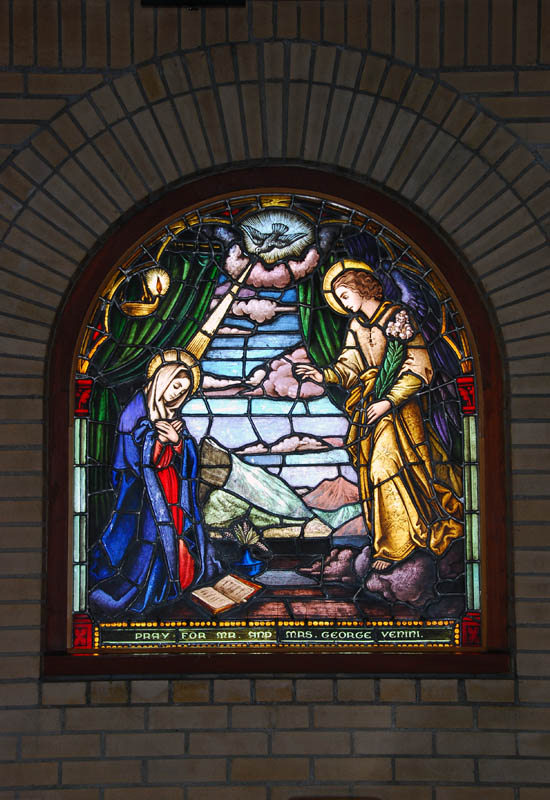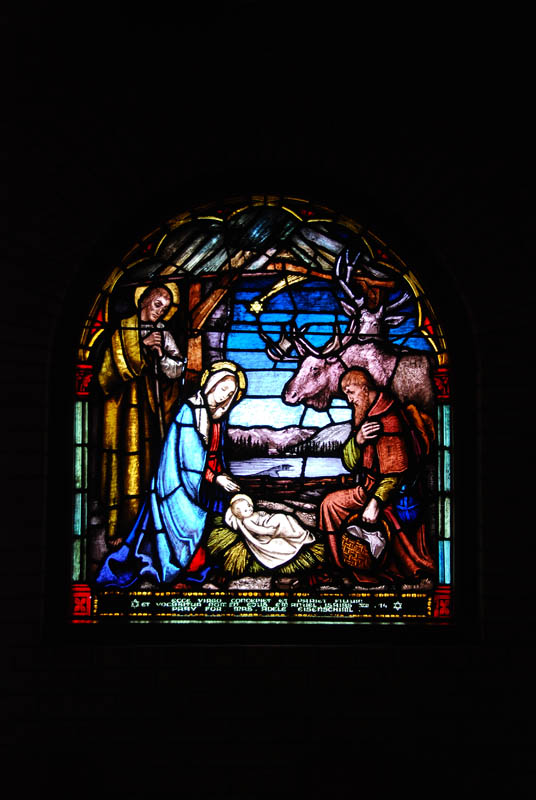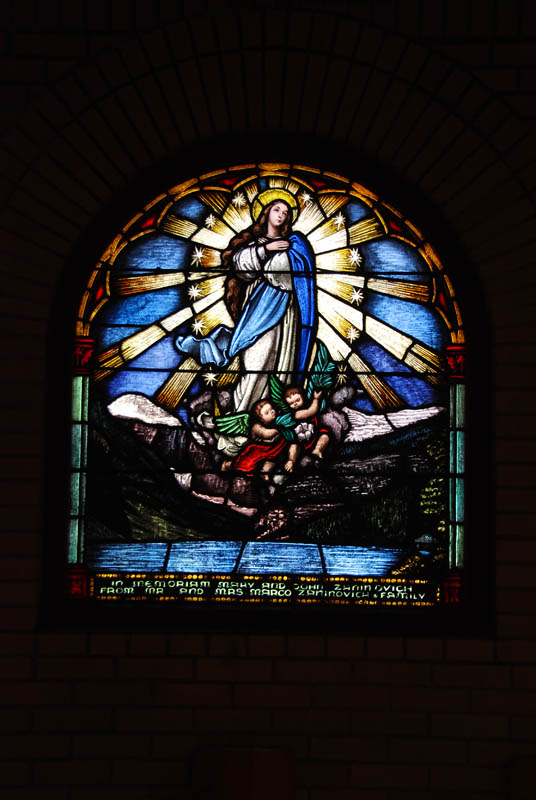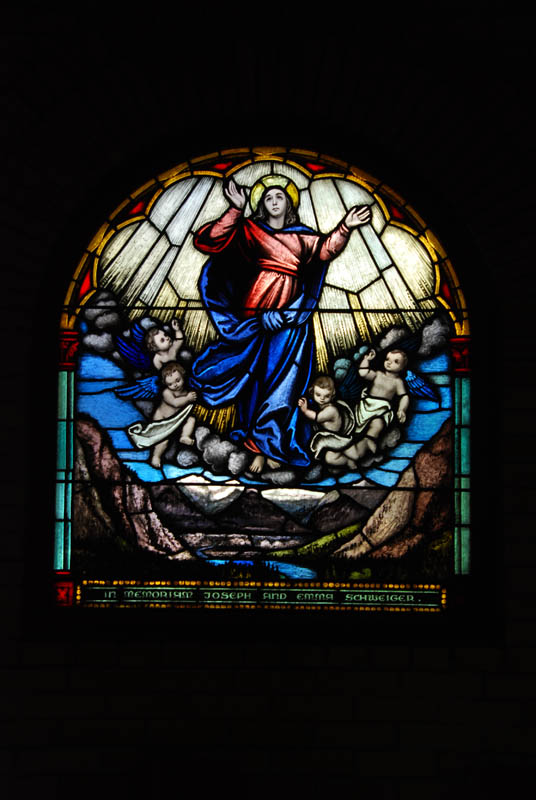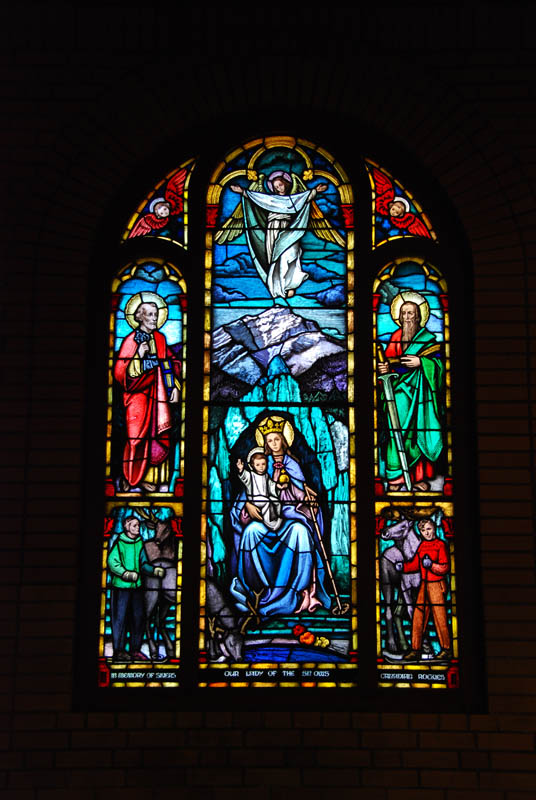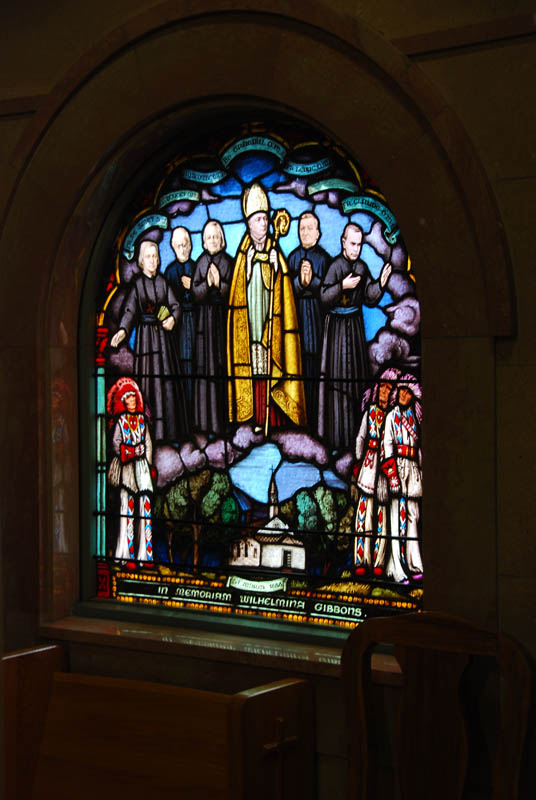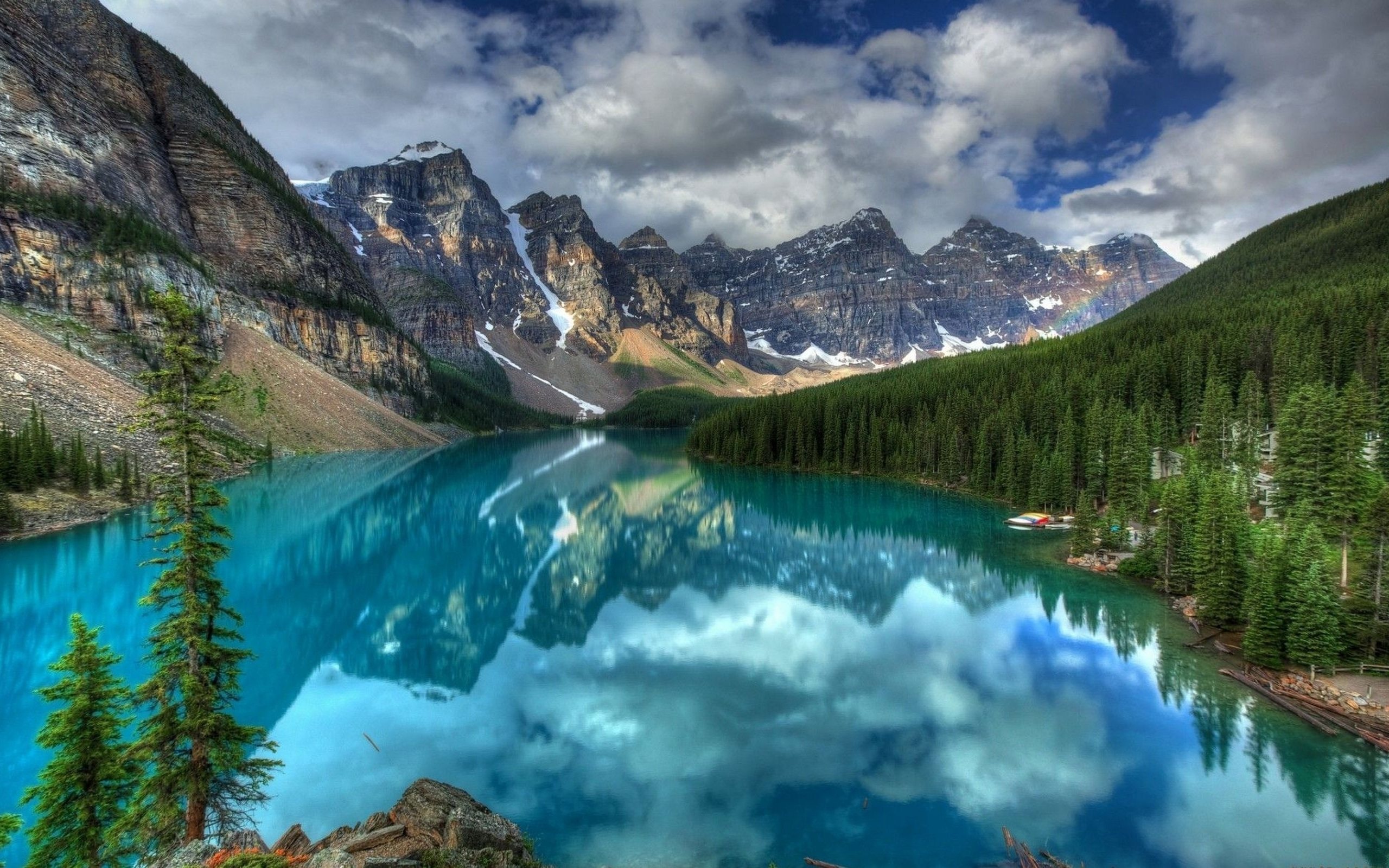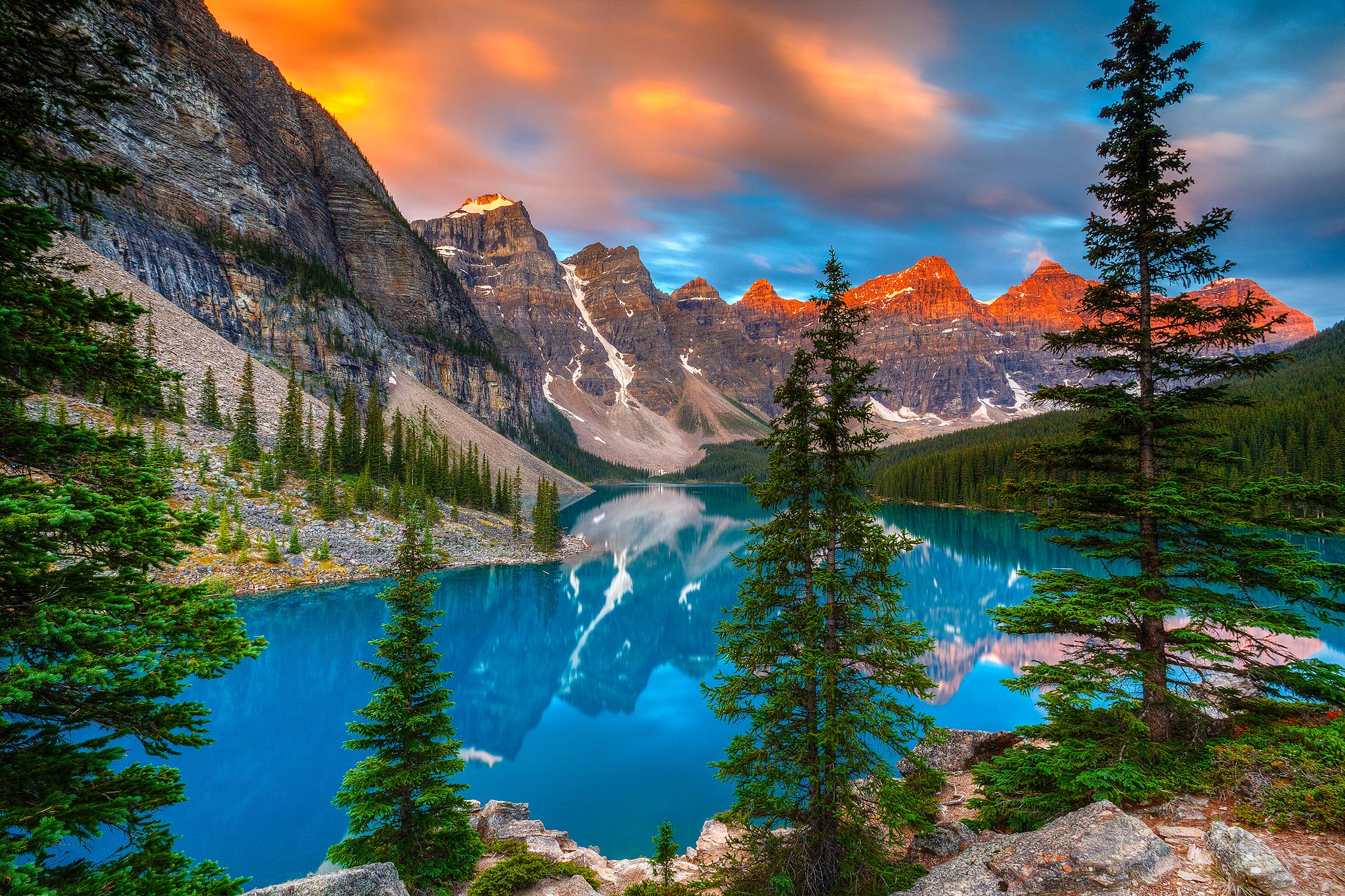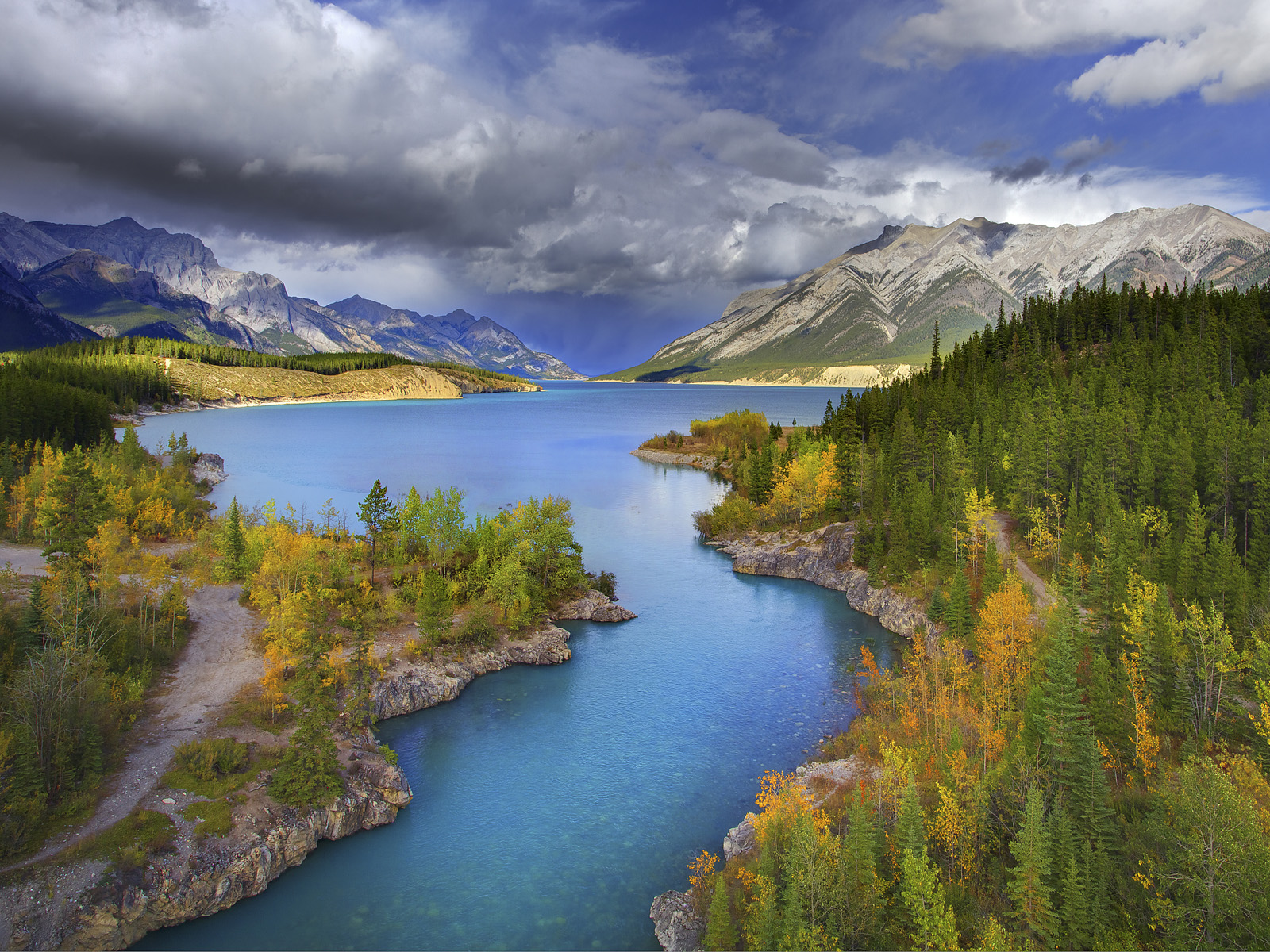THE HISTORY OF ST. MARY’S ROMAN CATHOLIC PARISH, BANFF, ALBERTA, CANADA
From the records and diaries of the Missionaries Oblates of Mary Immaculate (OMI) and the record of Father Robert McGuinness the following history of St. Mary’s Roman Catholic Parish has been culled.
At the request of the Hudson’s Bay Company; two priests Father Francois Blanchet and Father Modeste Demers, came from Quebec, to minister to the spiritual needs of the company’s employees at Fort Vancouver and Washington, USA. After making the intrepid journey across the whole expanse of Canada by waterways and portage, they entered the Rockies by way of the Athabasca Pass (now traversed by the Banff-Jasper Highway some 140 miles north of Banff). When they reached the Continental Divide at the Committee Punch Bowl, they offered their first mass at 3:00 am in the morning of October 10, 1833. Awed by the grandeur of the scenery and impressed by the magnificent setting of their altar amid God’s own Creation, the two priests consecrated the mountains around Banff to Almighty God. In 1843, Father Blanchet became the first Bishop of the Oregon Territory and Father Demers, in 1847, became the first Bishop of Victoria.
Almost 45 years were to elapse before the next mass was celebrated by Father E. Claude(OMI), on October 13, 1883, at Canadian Pacific Railroad Siding 29, which was at the base of Mount Cascade, now the Canadian Pacific Railroad Overpass. In 1886, the Banff Town site was moved from the base of Mt. Cascade to its present location south of the C.P.R. tracks. The Oblate Fathers from St. Mary’s, Calgary, continued to make mission visits and on August 4, 1886, Father Leduc said the first Mass in Banff, at the old Cascade Hotel. Father Moyses Blais (OMI) oversaw the Bow Valley Mission from 1887-1889. While visiting Banff with Bishop Vital Grandin(OMI), Bishop of St. Albert, in July 1887, property was leased, at lots 18, 19, 20 in Block 5, to build the first log church; where at present is the Scout Hall. The log cabin church was built by August 15, 1888 and was solemnly blessed and dedicated to ‘Our Lady of the Assumption’. It cost $800.00 to build. Loving called by local parishioners ‘St. Mary’s’. The celebrant and preacher at this mass of dedication was Fr. Albert Lacombe.
Later Fr. Blais leased lots 16 and 17; south of the present church. One interesting note is that on September 15, 1895, Bishop Vital Grandin (OMI) celebrated the High Mass and blessed the new bell which had been hung in the newly built bell tower; which was constructed by Brother Bowed (OMI). Engraved on the bell is OMI, Maria, Vital Grandin, Bishop of St. Albert, 1895. This bell is now in the Sanctuary of the present St. Mary’s Church a sends out its chimes at the consecration of Saturday and Sunday masses. The rectory was built in 1905 by Father Seltman (OMI) and he moved his mission headquarters from Cochrane to Banff on May 15 of that year. Banff was in the charge of the Oblate Missions until 1921 when it was placed under the care of secular priests.
On the drive from Banff to Minnewanka one sees several abandoned foundations of buildings about halfway along the road. This is all that remains of a thriving mining community that began in 1903. The first mass was offered in the Miner’s Hall on January 25, 1905, by Father Seltman (OMI), who began a church which was completed by Father Sylla (OMI), in 1908 and named The Most Holy Trinity. The mine closed in 1922 and the town was abandoned. All that remains are the altar stone which is in St. Mary’s Church, Banff.
In 1952 Fr. Robert McGuinness, who had become pastor in 1932, build the present church, on the corner of Lynx and Squirrel Streets.
Missionaries at Banff:
1885 Rev. D. Foisy, O.M.I.
1886 Rev. H. Leduc, O.M.I., Rev. L. Doucet, O.M.I.
1887-1889 Rev. M. Blais, O.M.I.
1890-1892 Rev. B. Desroches, O.M.I.
1892-1896 Rev. W. Comire, O.M.I.
1896-1899 Rev. L. Fouquet
Pastors:
1899-1907 Rev. J. Seltman, the first resident priest after 1905
1907-1922 Rev. H. Hermes, O.M.I., at Banff or Canmore
1912 Rev. L. V. Lewis, O.M.I. Rev. P. Murphy from St. Mary’s Cathedral, Calgary
1922-1930 Rev. John Osborne from Canmore
1930-1935 Rev. J. B. Moriarty, resident at Mineral Springs Hospital
1935-1936 Rev. J. F. Fitzpatrick
1936-1961 Rev. Robert McGuinness
1961-1967 Rev. Paul O’Byrne, built the hall and became Bishop of Calgary, in 1968
1967-1968 Rev. E. J. Cooney
1968-1969 Rev. W. O. MacCallum
1969-1971 Rev. A. McLellan
1971-1980 Rev. L. Redmond (purchased the present rectory)
1980-1982 Rev. R. McLellan
1982-1985 Rev. P. Luyckx
1985- 2001 Rev. Tom Garvey, C.S.Sp.
2001-2004 Rev. S. Vargas (parishes of St. Mary’s, Banff and Sacred Heart, Canmore were combined, under title of Our Lady of the Rockies)
2004-2007 Rev. R. Tiongson
2007-2008 Rev. V. Ha
2008-2015 Rev. Bryan Frank
2015- Rev. Daniel Stevenot (St. Mary’s, Banff was reinstated as a parish)
THE SISTERS OF SAINT MARTHA AND BANFF MINERAL SPRINGS HOSPITAL
The doors of the Brett Sanatorium, on Spray Avenue, which had been in use for 40 years, closed in 1926. For four years, it stood abandoned and Banff was without any medical facility except for a Doctor’s Clinic. In 1930, the Sisters of Saint Martha, of Antigonish, Nova Scotia, at the invitation of Bishop Kidd of Calgary came to Banff. They purchased the Brett Sanatorium for $58,000.00. In the four years, the hospital had stood dormant, pack rats had moved into its nooks, crannies and mattresses. A colony of bats had established itself in the attics. The mineral water had encrusted the pipes and tubs in the bathrooms so densely over the years that the use of chisels and hammers were required to remove the scale. On July 14, 1930, Bishop Kidd presided over the opening ceremonies of the renovated and newly named ‘Mineral Springs Hospital’.
Between 1945 and 1950 the Sisters of St. Martha decided to build a new hospital but were not getting support. Mother Ignatius, the Superior General of the Sisters of St. Martha, came to Banff, to meet with prominent people, National Park and Canadian Pacific Railroad officials. She informed them that the old, antiquated hospital was not fit for the sick. She informed them the Sisters were going to close the hospital and withdraw the nursing sisters within 6 months unless funding was arranged to build a new hospital. A new hospital was built with construction grants of $115,000.00. On July 22, 1958, Bishop Carroll of Calgary solemnly bless the new hospital and dedicated the chapel under the title of Christ the King. The civic opening was held on July 26, 1958.
This building is now the YWCA, across the street from the National Park Building, on Spray Avenue. A third hospital was build and officially opening on May 29, 1987, on Lynx Street. The Sisters gave the governance of the Banff Mineral Springs Hospital to Alberta Catholic Health Cooperation, now called Covenant Health, in 1987 and the last remaining sisters left in 1988. In honor of the sisters, the Continuing Care Unit is entitled, St. Martha Place, as well as the chapel which was dedicated by Bishop Henry of Calgary January 25, 2016.
An anecdote: In the early years, the hospital chapel was available for visiting clergy to celebrate mass. A sister would always be there to set up the altar and serve the mass. During the summer is was not uncommon for her to serve 25 to 30 masses a day. After each mass the visiting priest would be escorted to a special dining room where breakfast was served.
REVEREND ROBERT MCGUINNESS (1886-1961)
He was born in Liverpool, England, of Irish parentage, the eldest of eight children, on June 20,1886. The family immigrated to Canada in 1890 and settled in Belleville, Ontario; where he received his early education. He then attended St. Lawrence College, in Ampleforth, Yorkshire, England, St. Servan, Rheims, France and completed his studies, in Edmonton, Alberta, graduating from the School of Engineering. He found a position with the Federal Government, as a structural engineer, which he held for 20 years. His work was interrupted by World War I, during which he enlisted with the Royal Canadian Engineers and served for four years in France. After the war he traveled extensively, and it was later learned, had an interest in studying the construction of old Gothic, Romanesque churches.
After World War I, he returned to Canada and entered the Architectural Service of the Canadian Pacific Railway. He held the position of resident architectural engineer on the construction of the Chateau Banff Springs Hotel. He was a noted mountain hiker and skier, and was known for his oil paintings of the mountains, some of which we have in the church office today.
Always a deeply religious man and probably inspired by the grandeur of the mountains around Banff (perhaps skiing the slopes), at age 42, he responded to God’s call to a vocation in the Roman Catholic priesthood. He entered the Beda College seminary in Rome, Italy, 1926. He was ordained four later (1930) in the church of St. John Lateran, by Archbishop Joseph Palica, the Vice-General of Rome. His first mass was on the Feast of St. Patrick, March 17,1930, in St. John Lateran, Rome, Italy.
He had been studying to become a secular priest for the Diocese of Calgary, Alberta, Canada. His first assignment was as assistant priest of Sacred Heart Parish, Calgary. He was appointed a member of the Diocesan Construction Committee. He drew up plans for a new church of St. John’s, on 10th St. N.W., Calgary (which because of the depression was not completed till 1954 and has since burnt down). He is also credited with creating the plans for the interior of the unfinished St. Patrick’s Church, Medicine Hat, Alberta.
In 1934, he was appointed pastor of Sacred Heart of Jesus, Raymond, twenty miles south of Lethbridge. In 1936, he was appointed pastor of Our Lady of the Assumption (lovingly called St. Mary’s by the local parishioners), Banff. The church he had come to serve was the original Our Lady of the Assumption church, built in 1888 and the rectory build in 1905. Upon his arrival, the building fund for a new church had reached $1000.00; by 1950 this had escalated to $75.000.00. It became his dream, his vision, to build a new church. The present church was built in 1951. A church which would combine classic church architecture with magnificent mountain scenery to the honor of God. It was built according to the plans designed by Fr. McGuinness, in the Romanesque style. Churches built of rock are popular in the countryside of France and England. While studying in Rome he searched for craftsmen gifted in church finishing. When the time came, he could commission Walter Bacher of Innsbruck, Austria for the carving of the Stations of the Cross. Walter carved himself into the third and seventh stations in the left hand top corner. The man with what appears to be an air force helmet and glasses. The Tiroler Glasmalerei, Innsbruck, Austria to construct the stained-glass windows he had designed, which depict the life of Mary, the Blessed Mother of Jesus, set against local mountain scenery. A Dublin craftsmen was commissioned for the gold, bronze and silver fittings, and the building material were chosen from the surrounding mountains. The first mass was celebrated on Christmas Eve, 1951. It was blessed by Monsignor A.J. Hetherington in 1952 and renamed ‘The Assumption of the Blessed Virgin Mary’.
Fr. McGuinness was something of a loner, but was remembered for his kindness. A local café owner said of him, ‘I never knew a finer man.’ He embraced the whole community, and at the ground-breaking ceremony for the church, the person he chose to perform the honor was the owner of the local shoe shine parlor. (put in picture of ground breaking)
Ernie Kehr of the New York Herald-Tribune, wrote this about him, in the local Banff Craig & Canyon Newspaper. ‘As one who was privileged to know this extremely great man of God, almost from the first day he came to your town, I recognized in him a character of extraordinary talents and charity. What he did for the spiritual advancement of his parish in Banff, and for the tens of thousands of tourists who annually come to the mountains, can never be fully appreciated by anyone but his Maker! Even if we overlooked his personal kindness and inspiration, the St. Mary’s he planned and built will stand not only as the most beautifully wonderful ‘small’ church I’ve ever seen in the world, but as a lasting memorial to this humble man of God.’
Fr. McGuinness died in Calgary, on January 17, 1961, having been transferred from the Mineral Springs Hospital in Banff. He had been ill for about two months, from heart problems that seemed to develop after complicated hernia surgery. He had continued to lend physical labor to the finishing of the church, and his condition was aggravated while helping to move heavy altar pieces.
At the time of his death some work remained to be done on the church. The interior has been completed, except for the marble floor in the Baptistery. He had also planned to build a lych gate or bell tower where the grotto is. The parish hopes to complete this project. We have all the plans he left of the church and the bell tower.
A High Funeral Mass was celebrated by Monsignor Joseph Le Fort, at St. Mary, Banff and another the following day by Monsignor Heatherington, at St. Mary’s Cathedral, in Calgary. He is buried beside his father, Robert Senior, and his brother Leo, in St. Mary’s Cemetery. ‘May his soul and all the souls of the faithful departed rest in peace.’
Explanation of the Church Building and contents:
The church was built in the Romanesque Style; stone work and windows with rounded arches. As you enter on the right is a stained-glass window of St. Christopher, patron saint of Travelers; appropriate since Banff is primarily a place for tourists to visit. On the right are photos of the early days of Banff and the first church built in 1888.
Under the large stained-glass window of the crucifixion, donated by Fr. McGuinness in memory of his parents, Leo and, is a painting of him by Nicholas de Grandmaison. Mr. Grandmaison was a famous local artist, who mostly painted native chiefs, etc. Flanking the painting are to the left, a statue of St. Anne teaching Mary the 10 Commandments and to the right, a statue of St. Joseph, foster father of Jesus, holding the infant Jesus.
As you look to the altar you see to the left and right stained-glass windows depicting Mary, the mother of Jesus and different stages of her life. Fr. McGuiness designed all the windows. The background and many details in the windows are of Banff National Park.
Looking to the right walking down the aisle we first see the Annunciation, where the angel Gabriel is asking Mary to be the mother of Jesus. The background is of Rundle Mountain and the Spray Valley as seen from the Mt. Norquay ski lift.
Next is the Nativity of Jesus. No sheep, cow or donkey. We see moose and deer. Jesus is resting on Alberta wheat. The view is of the Bow River, looking west. There was a local Jewish man who was a friend of Fr. McGuinness. Since there was no synagogue he would pray in the old St. Mary’s and donated this window in memory of his family killed in the Holocaust. Notice the star of David in the sky.
On the left side starting, from the back of the church, is the Immaculate Conception (Mary born without sin). She is hovering over Lake Louise, with Victoria Glacier and Mt. Lefroy.
In the middle is the Assumption of Mary (ascending into heaven body and soul). The scene is one seen from the Banff Springs Hotel with the Bow Valley in the foreground and the mountains are the Fairholme Range.
In the front is the Crowning in Heaven of Mary, as Queen of Heaven and Earth, by Jesus. The back drop is Mount Assiniboine, a towering peak southwest of Banff. It is referred to as the Matterhorn of North America.
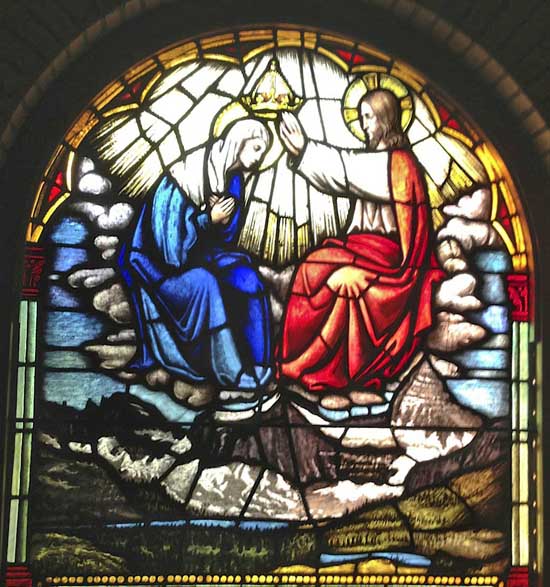
To the far left is the Our Lady of the Snows window. At the top of the window is a Guardian Angel. Below is Mary, holding the infant Jesus, who holds the world in his hand, in her lap. She is showing concern for the safety of skiers. She is seated in an ice grotto that is somewhat like those that decorate the Bow River in the winter. She holds a ski pole in her hand. By the angel are the apostles Peter (with the keys) and Paul (with the sword). Beside Mary are the skiers Hans Schneider and Rudy Matt, well known skiers during the time of Fr. McGuiness. The background is Cascade Mountain looking north along Banff Avenue.
Directly to the left of the altar is the window depicting the hierarchy His holiness Pope Pius XII, and Bishop Carroll, bishop of Calgary.
